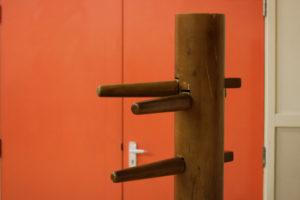First Form
Siu Nim Tao
The first form in the Wing Chun system is called Sil Lim Tao or sometimes referred to as Siu Nim Tao. Its interpretation, provides the reference point of the whole system. It is the foundation in which the whole system is built upon. Sil Lim Tao is training your intent and mindset to reduce complexity. Technically, this refers to the centreline theory, the Wing chun hand shapes and positions such as Bong Sau and Tan Sau. Furthermore, it places great emphasis on correct posture, breathing, concentration and thus relaxation and a form of meditation.
Second Form
Chum Kiu
The second form in the Wing Chun System is often referred to as ‘Searching Bridge’. But what does this really mean? Think of the two words that are being used, searching and bridge. At the point at which you learn Chum Kiu you should have grasped somewhat of a concept (and practiced) the first form Sil Lim Tao. This means that you should have been able to, at the basic level, apply the foundations in the techniques. Techniques such as Bong sau, Tan sau and Fook sau. Commonly, known as the three seeds of Wing Chun. Once you have achieved this, you naturally would want to ‘search’ or be more adventurous. You would want to be more combative and see how it works. Think of it logically, when you are ‘searching’ and you find a ‘bridge’, what is the purpose of a bridge? It is for you to walk on and get to the other side. In Chinese Kung Fu, the bridge refers to the hands and in combat its purpose is to get through, to hit, to strike. Hence, Chum Kiu. Simply put, when you have reached the Chum Kiu level, you should have grasped the basics of Siu Lim Tao and you are now applying more movement by utilising your hips known as ‘yiu ma’ in order to generate more force into the applications.
3rd Form
Biu TZE
The third form in Wing Chun is translated as ‘darting fingers’. Darting or Biu refers to the type of energy used. This form is taking the different stages that you learned through your development from the first and second form where you have learnt how to apply energy and power through relaxation and movement. We now include even more weaponry such as the fingers and elbows. The third form takes an even more humble approach by accepting that nothing is perfect and because of this, you may need a back up plan to be effective.
The Wooden Dummy
Mok Yahn Johng Faat
One of Wing Chun’s most famous training apparatus. Frequently, seen in many Wing Chun movies such as the IP MAN movies starring Donnie Yen. The wooden dummy is your training partner that doesn’t get tired. The development areas here teach you the correct hand positions, foot positions and angles. Furthermore, once this level is attained you can then learn to strike the dummy correctly and condition your body weapons. Your natural weapons such as your knuckles and palm strikes. Footwork plays a big part, knowing how to step and when to time that step with strikes.

Chi Sau
Bong Lap Sao
The first type that you learn. The momentum or ‘roll’ as many Wing Chun Practitioners call it, is based on a Bong Sao (helping hand) in conjunction with Wu Sao (Protecting hand), followed by a Lap Sao (Grappling hand). It focuses on the basic key fundamentals such as keeping your elbows in, center line positioning and expression of correct technique.
Dan Chi Sau
Known as Single Sticking Hands. It isolates one arm per time with the majority of the training maintaining the hands in constant contact, hence ‘sticking’. The three seeds of Wing Chun namely Bong Sao, Tan Sao and Fook Sao (which should have been planted by now) become further cultivated or ‘watered’ through this training method.
Pak Sau Chi Sau
Unique to the Wing Chun School family devised by my Si Gung. Its purpose is to address the mid-range. Wing Chun is very known for it’s close quarters combat, however, you need to get to that range first somehow. It’s like having a great bow and arrow, but if you’re not in the right range, it won’t be effective. Therefore, we mustn’t neglect the long and mid-ranges. The ‘Man Sao’ or asking hand, Wu Sao and the ‘Pak Sao’ or clapping hand come into play even more. The emphasis here is on the ‘touch and go’ reflexes and applying forward energy.
Poon Sau Chi Sau
Poon Sao or Double Sticking Hands – The most commonly seen type of Chi Sao. This is basically Dan Chi Sao or Single Sticking Hands, but now using two arms. All Wing Chun techniques, concepts and principals can now be expressed through play.
